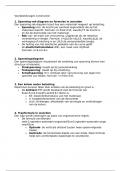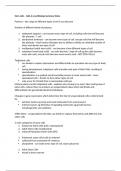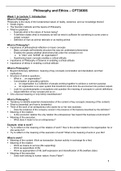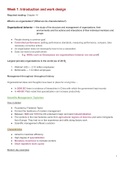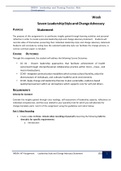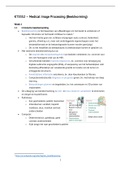Consciousness Explained Summary
- Lecture 1
What is consciousness? What is it for? Who has it? What happens when we lose it? Do we have
free will?
What is it like to be a bat? (Thomas Nagel) because bats have subjective experience other beings
can not completely know what it is like to be a bat (qualia). Colin McGinn-> we will never
completely know what consciousness is.
19th and 20th centuries-> consciousness is beyond normal science, its subjectivity puts the issue
beyond objectivity, so researchers stick to speculating about it.
Consciousness can be defined in many ways, which makes the subject difficult to study. The
global neuronal workspace theory is the most widely accepted.
Conscious perception is constructed in your brain, it is not an exact replica of the outside
world
❏ People make about 3 saccades per second, so part of the time we are blind. Purple dots
task-> dots disappear when the focus is on the + in the middle.
❏ Necker cube-> role of perspective, you only perceive one interpretation at a time
(positioning of the cube)
❏ Viral dress-> black/blue or white/gold?
❏ Green cone with checkered surface-> A and B have the same colour, the shadow illusion
causes them to be perceived as different colours.
❏ Ebbinghaus illusion-> perceived size of the central circle is affected by the size of the
surroundings.
❏ Motion illusion-> motion is constructed.
Is studying consciousness is different than studying other mental processes?
David Chalmers-> easy vs hard problem of consciousness. There is more to consciousness than
a physical brain process in the brain, the hard problem can’t be solved by neuroscience.
Easy problem (represent some ability or the performance of some function or behaviour, we
haven’t solved the problems yet but we know how) vs Hard problem (how and why some
internal states are subjective)
Some philosophers believe that the more we know about cognitive neuroscience, the hard
problem will start to disappear.
- Chapter 1
The Many Facets of Consciousness
Consciousness: the having of perceptions, thoughts and feelings; awareness. The term is
impossible to define except in terms that are unintelligible without a grasp of what consciousness
means. . . . Nothing worth reading has been written about it.
,—Stuart Sutherland, International Dictionary of Psychology (1996)
Conscious access-> selection of all stimuli to the conscious level (passing the same road over
and over again but not noticing many things). Selection and switch of attention control the entry
to the conscious mind because consciousness has limited capacity. (preconscious-> accessible
but not accessed) switch from preconscious to conscious puts the information into awareness.
Attention-> the taking possession by the mind (access), in clear and vivid form, of one out of
what seem several simultaneously possible objects or trains of thought (selection). Attention is
dissociable, making it operate largely unconsciously (the gateway for consciousness).
intransitive consciousness-> state of consciousness (“wakefulness”-> sleep-wake cycle or
“vigilance”-> excitement in the cortical and thalamic networks). Wakefulness, vigilance, and
attention are separately necessary but insufficient conditions for conscious access
(colour-blindness). Some people consider consciousness of self-awareness only (the self in the
act of knowing). Mirror-recognition test tests whether people or animals recognise themselves,
but does not sufficiently test consciousness. Mirror recognition can be passed by learning.
Metacognition-> thinking about your own mind, being both the perceived and the perceiver.
Comte argued that this is impossible. John Stuart Mill solved the problem-> the paradox
dissolves when the observing and the observed are encoded at different times or within different
systems. The prefrontal cortex-> monitors our plans, attach confidence to our decisions, and
detect our errors.
Minimal Contrasts
a pair of experimental situations that are minimally different but only one of which is
consciously perceived. Automatisation of behaviour makes the transition from conscious to
unconscious (typing). The opposite occurs too. When we focus on one point visually, the blind
spot is filled in using the information available in the visual field.
Rival Images
Binocular rivalry-> the alternation of perception when two different stimuli are presented to
each eye. In normal perception, the two images are fused into one (3D vision).
David Leopold and Nikos Logothetis-> recorded data from neurons in monkeys’ visual cortex.
The illusion was not present at the earliest stages of visual processing, in areas V1 and V2, where
most neurons encoded both images equally well. However, at higher levels of the cortical
hierarchy, particularly the brain areas inferotemporal cortex and STS most cells correlated with
subjective awareness. binocular rivalry proves that what matters to consciousness is not the
initial stage of peripheral visual processing (where both alternatives are still available) but a later
stage (at which a single winning image emerges).
When Attention Blinks
Attention to one image prolongs its time of perception.
Peng Zhang and his collaborators-> Alternation of images need not be reported by the person,
they can be tracked by the brain markers of rivalry (“frequency tagging,” ->each image is
“tagged” by flickering at its own specific rhythm). This is measured with an EEG.
,Attentional blink-> creating a brief period of invisibility of an image by temporarily saturating
the conscious mind. On a stream of symbols, when attending to the first symbol, the attention
blinks and misses the following symbol. All symbols enter the brain, but only processed ones
register into awareness. Despite the illusion, the conscious mind can not perceive two stimuli at
the same time. This bottleneck creates a processing delay-> psychological refractory period.
While the first item is being processed, the second item waits in an unconscious buffer. Even
when two inputs are objectively simultaneous, we fail to perceive their simultaneity and
systematically feel that the first one that we attended to appeared earlier than the other. Due to
noise or other disruptors, the buffered item can disappear (blink). Inattentional blindness->
long periods of mental isolation when attending to cognitively demanding tasks (the invisible
gorilla). Change blindness-> inability to detect which part of a picture has been erased when
images are presented (often with a short blank between them) (asking for directions experiment).
Choice blindness-> when people don’t notice their initially chosen choice doesn’t match the
later presented option.
Masking Conscious Perception
Some researchers suggest that, during change blindness experiments, participants are always
aware of the whole scene but simply fail to commit most of the details to memory. Masking->
subliminal images. flashing a picture, surrounded in time by other similar shapes that act as
masks and prevent its conscious perception.
Primacy of the Subjective
subjective reports can and should be trusted. Masking drastically reduces our naming and
memory abilities. human observers are neither random nor whimsical about their subjective
reports: when they report an honest-to-god feeling of seeing, such conscious access corresponds
to a massive change in information processing, which almost always results in enhanced
performance. introspection is a respectable source of information, but it does not directly reflect
the operations of the mind because we don’t have access to many unconscious processes.
Out-of-body experiences happen subjectively and these can be seen in neuroimaging.
- Lecture 2
Daniel Dennett-> the factory is empty (against Chalmers’ dualism), the mind is a mechanism.
mysterianism-> we are too stupid to understand consciousness. materialism-> all emergent
phenomena are the result of material properties and interactions in the brain. dualism-> mind
and body are not identical, consciousness can’t be reduced to pure brain activity.
Defining consciousness-> vigilance (state of wakefulness), attention (focusing mental resources
on a specific piece of information, conscious access (attended information enters awareness and
becomes reportable). Conscious content (experience: subliminal, conscious, preconscious etc.)
vs state (wakefulness or vigilance).
, Brain lesions
Blindsight-> damage to the occipital lobe. Inability to see specific parts of the visual field, but
still, receive unconscious information. In the image below it can be seen that damage in one
hemisphere is reflected in the opposite visual field. Blindsight patients have above-average
performance when reporting visual stimuli, which suggests processing. Information travels from
the dorsal stream, meaning that they can still use the information, but they aren’t aware. Bilateral
lesions can also occur, but unconscious awareness is still intact.
Visuospatial neglect-> damage to TPJ. ignorance of one side of the
visual field. The patient has a perception of the field, but they can’t
attend to it.
- Lecture 1
What is consciousness? What is it for? Who has it? What happens when we lose it? Do we have
free will?
What is it like to be a bat? (Thomas Nagel) because bats have subjective experience other beings
can not completely know what it is like to be a bat (qualia). Colin McGinn-> we will never
completely know what consciousness is.
19th and 20th centuries-> consciousness is beyond normal science, its subjectivity puts the issue
beyond objectivity, so researchers stick to speculating about it.
Consciousness can be defined in many ways, which makes the subject difficult to study. The
global neuronal workspace theory is the most widely accepted.
Conscious perception is constructed in your brain, it is not an exact replica of the outside
world
❏ People make about 3 saccades per second, so part of the time we are blind. Purple dots
task-> dots disappear when the focus is on the + in the middle.
❏ Necker cube-> role of perspective, you only perceive one interpretation at a time
(positioning of the cube)
❏ Viral dress-> black/blue or white/gold?
❏ Green cone with checkered surface-> A and B have the same colour, the shadow illusion
causes them to be perceived as different colours.
❏ Ebbinghaus illusion-> perceived size of the central circle is affected by the size of the
surroundings.
❏ Motion illusion-> motion is constructed.
Is studying consciousness is different than studying other mental processes?
David Chalmers-> easy vs hard problem of consciousness. There is more to consciousness than
a physical brain process in the brain, the hard problem can’t be solved by neuroscience.
Easy problem (represent some ability or the performance of some function or behaviour, we
haven’t solved the problems yet but we know how) vs Hard problem (how and why some
internal states are subjective)
Some philosophers believe that the more we know about cognitive neuroscience, the hard
problem will start to disappear.
- Chapter 1
The Many Facets of Consciousness
Consciousness: the having of perceptions, thoughts and feelings; awareness. The term is
impossible to define except in terms that are unintelligible without a grasp of what consciousness
means. . . . Nothing worth reading has been written about it.
,—Stuart Sutherland, International Dictionary of Psychology (1996)
Conscious access-> selection of all stimuli to the conscious level (passing the same road over
and over again but not noticing many things). Selection and switch of attention control the entry
to the conscious mind because consciousness has limited capacity. (preconscious-> accessible
but not accessed) switch from preconscious to conscious puts the information into awareness.
Attention-> the taking possession by the mind (access), in clear and vivid form, of one out of
what seem several simultaneously possible objects or trains of thought (selection). Attention is
dissociable, making it operate largely unconsciously (the gateway for consciousness).
intransitive consciousness-> state of consciousness (“wakefulness”-> sleep-wake cycle or
“vigilance”-> excitement in the cortical and thalamic networks). Wakefulness, vigilance, and
attention are separately necessary but insufficient conditions for conscious access
(colour-blindness). Some people consider consciousness of self-awareness only (the self in the
act of knowing). Mirror-recognition test tests whether people or animals recognise themselves,
but does not sufficiently test consciousness. Mirror recognition can be passed by learning.
Metacognition-> thinking about your own mind, being both the perceived and the perceiver.
Comte argued that this is impossible. John Stuart Mill solved the problem-> the paradox
dissolves when the observing and the observed are encoded at different times or within different
systems. The prefrontal cortex-> monitors our plans, attach confidence to our decisions, and
detect our errors.
Minimal Contrasts
a pair of experimental situations that are minimally different but only one of which is
consciously perceived. Automatisation of behaviour makes the transition from conscious to
unconscious (typing). The opposite occurs too. When we focus on one point visually, the blind
spot is filled in using the information available in the visual field.
Rival Images
Binocular rivalry-> the alternation of perception when two different stimuli are presented to
each eye. In normal perception, the two images are fused into one (3D vision).
David Leopold and Nikos Logothetis-> recorded data from neurons in monkeys’ visual cortex.
The illusion was not present at the earliest stages of visual processing, in areas V1 and V2, where
most neurons encoded both images equally well. However, at higher levels of the cortical
hierarchy, particularly the brain areas inferotemporal cortex and STS most cells correlated with
subjective awareness. binocular rivalry proves that what matters to consciousness is not the
initial stage of peripheral visual processing (where both alternatives are still available) but a later
stage (at which a single winning image emerges).
When Attention Blinks
Attention to one image prolongs its time of perception.
Peng Zhang and his collaborators-> Alternation of images need not be reported by the person,
they can be tracked by the brain markers of rivalry (“frequency tagging,” ->each image is
“tagged” by flickering at its own specific rhythm). This is measured with an EEG.
,Attentional blink-> creating a brief period of invisibility of an image by temporarily saturating
the conscious mind. On a stream of symbols, when attending to the first symbol, the attention
blinks and misses the following symbol. All symbols enter the brain, but only processed ones
register into awareness. Despite the illusion, the conscious mind can not perceive two stimuli at
the same time. This bottleneck creates a processing delay-> psychological refractory period.
While the first item is being processed, the second item waits in an unconscious buffer. Even
when two inputs are objectively simultaneous, we fail to perceive their simultaneity and
systematically feel that the first one that we attended to appeared earlier than the other. Due to
noise or other disruptors, the buffered item can disappear (blink). Inattentional blindness->
long periods of mental isolation when attending to cognitively demanding tasks (the invisible
gorilla). Change blindness-> inability to detect which part of a picture has been erased when
images are presented (often with a short blank between them) (asking for directions experiment).
Choice blindness-> when people don’t notice their initially chosen choice doesn’t match the
later presented option.
Masking Conscious Perception
Some researchers suggest that, during change blindness experiments, participants are always
aware of the whole scene but simply fail to commit most of the details to memory. Masking->
subliminal images. flashing a picture, surrounded in time by other similar shapes that act as
masks and prevent its conscious perception.
Primacy of the Subjective
subjective reports can and should be trusted. Masking drastically reduces our naming and
memory abilities. human observers are neither random nor whimsical about their subjective
reports: when they report an honest-to-god feeling of seeing, such conscious access corresponds
to a massive change in information processing, which almost always results in enhanced
performance. introspection is a respectable source of information, but it does not directly reflect
the operations of the mind because we don’t have access to many unconscious processes.
Out-of-body experiences happen subjectively and these can be seen in neuroimaging.
- Lecture 2
Daniel Dennett-> the factory is empty (against Chalmers’ dualism), the mind is a mechanism.
mysterianism-> we are too stupid to understand consciousness. materialism-> all emergent
phenomena are the result of material properties and interactions in the brain. dualism-> mind
and body are not identical, consciousness can’t be reduced to pure brain activity.
Defining consciousness-> vigilance (state of wakefulness), attention (focusing mental resources
on a specific piece of information, conscious access (attended information enters awareness and
becomes reportable). Conscious content (experience: subliminal, conscious, preconscious etc.)
vs state (wakefulness or vigilance).
, Brain lesions
Blindsight-> damage to the occipital lobe. Inability to see specific parts of the visual field, but
still, receive unconscious information. In the image below it can be seen that damage in one
hemisphere is reflected in the opposite visual field. Blindsight patients have above-average
performance when reporting visual stimuli, which suggests processing. Information travels from
the dorsal stream, meaning that they can still use the information, but they aren’t aware. Bilateral
lesions can also occur, but unconscious awareness is still intact.
Visuospatial neglect-> damage to TPJ. ignorance of one side of the
visual field. The patient has a perception of the field, but they can’t
attend to it.



